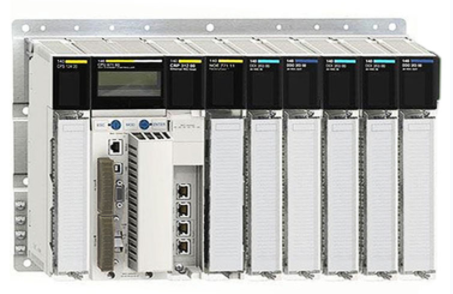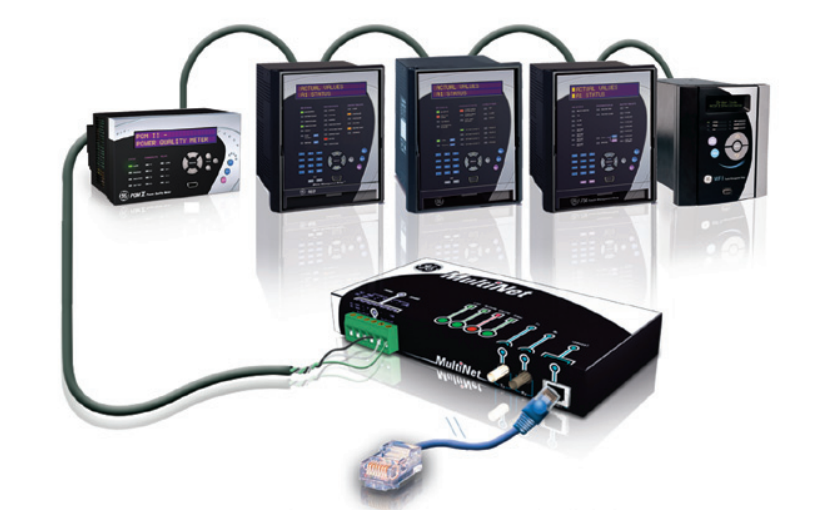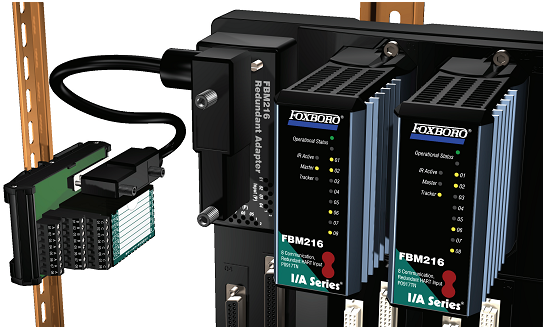5 methods to improve the reliability of PLC control system

A. Suitable working environment
Suitable ambient temperature
Each manufacturer has certain regulations on the ambient temperature of the PLC. Usually, the ambient temperature allowed by PLC is about 0~55°C. Therefore, in the installation process, do not place a large number of heating elements under the PLC; There must be enough ventilation and heat dissipation space around the PLC; Do not install the PLC directly in sunlight or near heating equipment, such as heating, heaters and high power supplies. There are ventilated curtains where the PLC is installed. If the temperature of the control cabinet is too high, install fans in the cabinet for forced ventilation.
2. Suitable for ambient humidity
The relative humidity of PLC working environment is generally less than 85 to ensure the insulation performance of PLC. High humidity can also affect the accuracy of analog input/output devices. Therefore, the PLC should not be installed where condensation or rain is caused.
3. Pay attention to environmental pollution
It is not recommended to install the PLC in the place with a large amount of pollutants (such as dust, fume, iron powder, etc.), candle burning gas and combustible gas, especially in the place with corrosive gas, which may lead to corrosion of components and printed circuit boards. If it can only be installed in such a place, the PLC can be turned off when the temperature permits; Or PLC can be installed in the control room with high air tightness, and air purification device is installed.
4. Keep away from vibration and shock sources
The control cabinet for installing PLC should be far away from places with strong vibration and impact, especially continuous and frequent vibration. If necessary, take appropriate measures to mitigate the effects of vibration and shock to avoid loosening wiring or plug-ins.
5. Stay away from strong sources of interference
PLC should be far away from strong interference sources, such as high-power thyristor devices, high-frequency equipment and large power supply equipment. At the same time, the PLC should also be away from strong electromagnetic field and strong radioactive sources, and vulnerable to the influence of strong static electricity.

B. Install and connect cables properly
1. Install the power supply
Power supply is the main way of interference into PLC. PLC systems have two types of power supply: external power and internal power.
External power supply is used to drive PLC output equipment (load) and provide input signals, also known as user power supply. The same PLC external power supply may have a variety of specifications. The capacity and performance of the external power supply are determined by the output device and the input circuit of the PLC. Because the I/O circuit of PLC has the function of filtering and isolation, the external power supply has little influence on PLC performance. Therefore, the requirements for external power supply are not high.
Internal power supply is the working power supply of PLC, that is, the working power supply of PLC internal circuit. Its performance directly affects the reliability of PLC. Therefore, in order to ensure the normal operation of PLC, the internal power supply requirements are very high. The internal power supply of general PLC uses switching voltage regulator power supply or voltage regulator power supply, the primary side with a low-pass filter.
In the case of strong interference or high reliability requirements, the shielding system is used to power the PLC system. LC filter circuits can also be connected in series on the secondary side of the isolation transformer. At the same time, the following problems should be paid attention to during the installation process:
2) The power cord of the system should be thick enough to reduce the line voltage drop caused by the startup of large-capacity equipment;
3) When the PLC input circuit uses external DC power supply, the most use regulated power supply to ensure that the input signal is correct. Otherwise, the PLC may receive an error signal.
2. Stay away from high stress
The PLC cannot be installed near the high voltage electrical appliances and high voltage power lines, nor can it be installed in the same control cabinet with the high voltage electrical appliances. The PLC in the cabinet should be kept away from the high-voltage power cable, and the distance between them should be greater than 200mm.
3. Connect cables properly
1) I/O lines, power lines and other control lines should be wired separately. Try not to put them in the same line slot.
2) AC line and DC line, input line and output line are well separated.
3) the switching quantity and the simulation I/O line are separated. For I/O lines that transmit analog signals, use shielded lines whose shielding layer should be grounded at one end.
4) The signal transmitted between the PLC basic unit and the extended unit is small, high frequency and easy to be interfered with. It cannot be buried in the same slot with other cables.
5) When connecting PLC I/O circuit, crimping terminal or single strand must be used. It is not suitable to use multiple strands to connect PLC terminals directly, otherwise spark will easily occur.
6) Installed in the same control cabinet as PLC. Although it is not an inductor controlled by PLC, it should also be connected in parallel with RC or diode arc-extinguishing circuits.

C. Ground the device correctly
Good grounding is an important condition for safe and reliable operation of PLC. To suppress interference, PLCS are usually grounded separately, and their respective grounding devices are used separately from other devices. Common grounding can also be used. However, the series grounding method shown in Figure 6-37c is prohibited because this method may cause potential difference between the PLC and the device.
The PLC ground cable should be as short as possible so that the ground point is as close to the PLC as possible. The ground resistance must be less than 100 ohms, and the cross section of the ground cable must be greater than 2mm2.
In addition, the CPU unit of the PLC must be grounded. If the I/O expansion unit is used, the CPU unit must have a common ground body, and the protection grounding resistance of any unit must not exceed 100 Ohms.

D. Necessary safety protection links
Short circuit protection
When the PLC output equipment short circuit, in order to avoid damage to the PLC internal output components, should be installed in the PLC external output circuit fuses for short circuit protection. It is very suitable for installing fuses in each load cycle.
2. Interlocking and interlocking measures
In addition to ensuring the interlocking relationship of the circuit in the program, the hardware interlocking measures should also be taken in the external wiring of the PLC to ensure the safe and reliable operation of the system, such as the motor positive and negative control, and the contacters KM1 and KM2 should be closed normally. Points are interlocked outside the PLC. When there are interlocking requirements between different motors or equipment, the most important thing is to perform hardware interlocking outside the PLC. It is a common practice in PLC control systems to use hardware outside PLC to perform interlocking and interlocking.
3. Loss of pressure protection and emergency stop measures
Power lines for PLC external loads should be voltage protected. If the "Start" button is not pressed when the power supply is restored after a temporary power failure, the PLC external load cannot be started. Another function of this wiring method is that when emergency stop is needed under special circumstances, pressing the "stop" button can cut off the load power, regardless of PLC.
Sometimes hardware measures may not completely eliminate the effects of interference. The adoption of certain software coordination measures to improve the anti-interference ability and reliability of PLC control system has played a very good role.
1. Eliminate the jitter of the switching input signal
In practice, when the input signal of some switches is turned on, the phenomenon of "jitter" will appear when the switch is on due to external interference. This phenomenon is generally not affected by the electromagnetic inertia of the relays in the relay system. However, in the PLC system, because the PLC scanning speed is fast, the scanning period is much shorter than the actual relay operation time, so the jitter signal may be detected by the PLC, leading to the wrong results. Therefore, some "jitter" signals must be handled to ensure proper system operation.
Input signal jitter and its elimination
a) the influence of jitter phenomenon b) the method to eliminate jitter
2. Detect and diagnose faults
PLC has high reliability and perfect self - diagnosis function. If a PLC fails, the self-diagnosis program can easily find the cause of the failure and then resume normal operation after elimination.
A large number of engineering practice shows that PLC external input and output equipment failure rate is much higher than PLC itself failure rate. After the failure of these devices, the PLC is usually unable to detect it, which may cause the failure to expand until the strong current protection equipment is operational. It just stops, sometimes leading to accidents with equipment and people. After a shutdown, it takes a lot of time to find the fault. In order to find the fault in time, PLC will automatically stop and alarm before the accident. In order to facilitate fault finding and improve maintenance efficiency, PLC program can be used to realize fault self-diagnosis and self-treatment.
Modern PLC has a large number of software resources. For example, FX2N series PLCS have thousands of auxiliary relays and hundreds of timers and counters. They have a considerable margin for fault detection.
(1) The time required by delay detection mechanical equipment in each step is usually constant, even if the change is not too large, so these times can be used as reference output output signal. When the action starts, the PLC and the corresponding external actuator A timer start, and the timer is set to approximately 20 inches longer than the normal duration of the action. For example, if an actuator (such as an electric motor) runs under normal conditions for 50 seconds, the actuated component causes the limit switch to act and signals the end of the action. If the working time of the actuator exceeds 60s (that is, the setting time of the corresponding timer), the PLC does not receive the action end signal, the normally open contact of the timer delay is connected, and the signal stops the normal cycle. This program starts the alarm and fault display program so that operators and maintenance personnel can quickly identify the fault type and take timely measures to eliminate the fault.
(2) Logic error detection When the system is running normally, PLC input and output signals have a certain relationship with internal signals (such as the status of auxiliary relays). If an abnormal logical signal occurs, a fault occurs. . Therefore, you can write exception logic relationships for some common faults. Once the exception logical relation is ON, you should follow the error. For example, during mechanical movement, there are two limit switch actions. These two signals don't turn on at the same time. If they are both open, at least one limit switch is stuck and processing should be stopped.
3. Eliminate predictive distractions
Some of the disruptions are predictable. For example, the PLC output commands that make actuators (such as high-power motors and electromagnets) work are usually accompanied by interfering signals such as sparks and arcs. The interference signals they generate may cause the PLC to receive incorrect information. . When these disturbances are easy to occur, some input signals of PLC can be blocked by software, and the blocking can be cancelled after the interference prone period has passed.

E. Use a redundant or hot spare system
Some control systems (e.g. chemical, paper, metallurgical, nuclear, etc.) require extremely high reliability. If the control system failure, production or equipment damage will cause huge economic losses. Therefore, it is impossible to meet the requirements only by improving the reliability of PLC control system. In large systems requiring extremely high reliability, redundant systems or hot standby systems are often used to effectively address the above problems.
The redundant system
The so-called redundant system means that there is a redundant part in the system, the system does not work properly, but if the system fails, the redundant part can immediately replace the faulty part and keep the system running normally. A redundant system is usually an important part of a control system (such as a CPU module) that consists of two identical sets of hardware. When one group fails, it is immediately controlled by the other. Whether to use two identical I/O modules depends on the reliability requirements of the system.
Two groups of CPU modules work in parallel using the same program. One group is the primary CPU module and the other group is the standby CPU module. When the system is running properly, the output of the standby CPU module is disabled, and the active CPU module controls the system running. Meanwhile, the primary CPU module continuously refreshes the I/O image registers and other registers of the standby CPU module through the redundant processing unit (RPU). After the active CPU module sends a fault message, the RPU switches control functions to the standby CPU within one to three scan cycles. I/O system switching is also performed by the RPU.
a) Redundant system b) hot spare system
2. Hot spare system
Despite having two CPU modules running a program at the same time, the hot standby system has a simpler structure than the redundant system, but there is no redundant processing unit RPU. The main CPU module communicates with the standby CPU module through the communication port. The two groups of cpus are connected together through a communication interface. When the system fails, the primary CPU notifies the secondary CPU and implements a switchover, which is usually slow.
More...